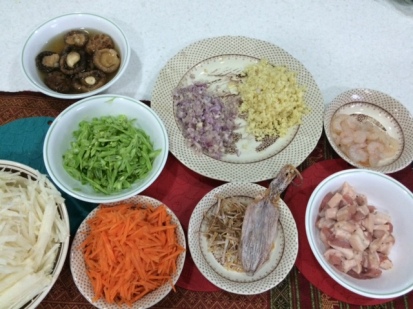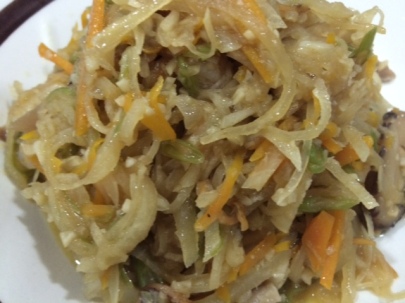Mum’s not been well lately. For a while she was recovering, but with the recent passing of her youngest brother, her health got worse and she slipped into a depression that I’ve never seen before. They were close, but it was probably harder on her because not only are there now four out of 10 siblings left, but they – my mother and my uncle – were close. They spoke every other day, even though they didn’t see each other that often.
I couldn’t understand it at first; people pass on, unexpected or not, the living grieve for a while and then get on with their lives.
But seeing my mother take to her bed, not eat, not talk, not move unless necessary got me first worried then anxious and then panicky. I began focusing all my energy and attention on getting her well, tossing most other activities by the wayside. Seeing her decline made me realise that I was not ready to lose her. I wasn’t mentally and emotionally equipped for it.
Mother and I didn’t start out having a good relationship. Growing up, we were almost always at odds with each other. I was an angry teenager, she was an almost typical controlling, domineering mother, brought up in the nyonya tradition of what a woman should be – quiet, well-mannered, well-trained in the kitchen, a woman who should be a compliment to a husband and a matriarch to her new family. I can’t even begin to enumerate the battles we used to have; some loud and angry, but mostly quiet and cold.
Our relationship only started improving after I moved out in my late 20s, something that is Just, Not. Done. by any female in a good Peranakan family. A woman does not move out of the family house unless it is to her husband’s house. Even then, she would try to get me married off, mentioning “that nice boy” that some wattle-chinned flappy-armed old matchmaker scraped up from only the gods knew where, and trying to persuade me to “meet only”, “no harm getting to know new people”.
Thinking back, much of my rebellion began in the kitchen, where a good nyonya girl was expected to learn not just the family recipes but also other kitchen skills, including knowledge of spices and good knife skills. I remember being in the kitchen with her and my maternal grandmother where she would castigate me for sloppy knife work.
Slicing and julienning vegetables were an endurance test, with her looking over my shoulder, chastising me for being so “cho lor*”, commenting on how kasar** and chunky my vegetables were.
The most painful dish for me to help prepare was always, hands down, jiu hu char, stir fried shredded cuttlefish with vegetables, a quintessential Penang dish. While the main ingredient of the dish is actually the lowly turnip, not having dried shredded cuttlefish in the dish is just unacceptable.
Ironically, it was only after I moved out and started cooking for myself and my housemates that my knife skills started improving, Even now, however, I slip up. I don’t practice enough. But, unbeknownst to mother, I have been practising the jiu hu char recipe.
The Ingredients for jiu hu char


- Two medium sized turnips also known in Hokkien as bangkuang, about 500gm – 600gms
- Two medium carrots
- About 250gms of long beans
- Four to five mid-sized shallots
- Half a bulb of garlic
- About 150gms of pork belly
- About 70gms of small prawns
- Five to six dried shiitake mushrooms
- Five to six pieces of small dried cuttlefish
- Handful of chopped coriander for garnishing
- A few sprigs of spring onions, to be diced for garnishing
- Light soy sauce
- Dark soy sauce
- Pepper
- Sugar
- Salt
- Oil
Step One: Prep
- Soak the dried mushrooms in water. Reserve the stock for later. Mushroom stock is a great flavour agent, giving your food a more umami mouthfeel. Once the mushrooms are soft, slice them thinly.
- Soak the dried cuttlefish for a few minutes, then julienne or shred them.
- Slice and julienne all the vegetables. Of course, with all the latest technology, we can use the food processor now, but the old school methods are still the best for this. i find that using a food processor makes the vegetables a bit soggier, while julienning by hand ensures better crispness.
- Boil the pork belly with a couple of crushed garlic cloves; it helps to get rid of any residual “porky” smell. Also makes it easier to slice the pork thinly, once its cooked. But if you forget that step or have no issues with smell, just slice the pork belly thinly.
- Chop the shallots and remaining garlic cloves finely.
- Depending on how many pairs of hands there are in the kitchen and whether you’re using a food processor or julienning, prep can take anywhere from 20 to 90 minutes.
Step Two: Cooking
- Heat oil in in wok. About one third of a cup should do, but you can add more if you want. I prefer the vegetables less oily and slightly dry as it holds its shape better.
- Add chopped garlic and shallots and fry until translucent.
- Add the shredded cuttlefish. Fry on low fire until aromatic.
- Add the pork, fry for a minute or two more.
- Add the julienned turnip, carrots and green beans.
- Stir fry until the vegetables are slightly soft.
- Add the mushrooms, together with half the mushroom stock. Stir it around some more.
- Taste.
- Keep stirring until the liquid has dried somewhat.
- Add about a teaspoonful of light soy sauce, a sprinkle of salt and pepper (about half a teaspoon should do) and the rest of the mushroom stock and stir the vegetables thoroughly.
- Cover the wok with a lid for about five minutes.
- By the time you get back to it, the vegetables should be fairly soft.
- Taste.
- Add the prawns and a little of the pork stock, if you boiled the pork, to moisten the vegetables. Sprinkle about a teaspoon of sugar. Stir. Some people leave off the prawns but I find that they add natural sweetness to the dish and give it better mouthfeel than plain sugar.
- Mix a teaspoon of dark soy sauce, equal amount of light soy sauce, if you think the dish needs more salt, and about a quarter of a cup of water.
- Add to vegetables.
- Stir fry until prawns are cooked. By this time, the vegetables should be thoroughly cooked and soft yet retain a slight crunchiness. There should also be very little liquid left. The shredded vegetables should not clump together; you should be able to see individual strands of turnip and carrot.
- Taste. Season with salt and pepper accordingly.
Congratulations, you have just cooked jiu hu char, a dish synonymous with the Penang Peranakans. Eat either with hot white rice or as the filling in a sambal belacan smeared lettuce leaf.
I hope mum gets well enough soon for me to cook this for her. It will be a role reversal.

Joyce
* Cho lor – Hokkien. Translates to rough, but usually used in relation to people. It usually means the person is clumsy or unrefined, not something one wants to hear in the description of someone.
** Kasar – Malay. Translates to rough, or coarse. If used to describe a person, it usually means the person is coarse, unrefined, not really bad mannered but not quiet clued in on social niceties.

Great post Joyce. I relate to so many of your memories – I shared many of the same experiences with my mom. Looking back now, I wish I paid more attention in the kitchen when she tried to teach me, rather than rebel. Sending positive energy your way and your mom’s way for her quick recovery.
LikeLike
Great post Jocye. I relate to so many of your memories. I shared many of the same experiences with my mom, when I was growing up. Looking back now, I wish I had paid more attention when she was trying to teach me to cook, instead of rebelling. Ah well. Sending positive energy to you and your mom for her quick recovery.
LikeLike
Hey Eve, glad you read this. I will be blogging more, it’s cathartic to go back to my first love, writing. Hope you’re well. Coming back to Malaysia soon? If not, look out for recipes here. 🙂
LikeLiked by 1 person
Hopefully, at the end of the year. Enjoy the blogging – yes, it can be cathartic. Will watch for recipes and try them out… if I’m brave enough. 🙂
LikeLike
Hi Eve, go ahead and try them. More recipes coming. I’ll try and make them idiot proof. 🙂
LikeLiked by 1 person
Thanks for your sharing. Hope your mum finds peace and recover soon.
LikeLike
You’re welcome Susan. I’m glad you enjoyed reading this. Please do try the recipe as well and feel free to email me if you have any questions on it.
LikeLike